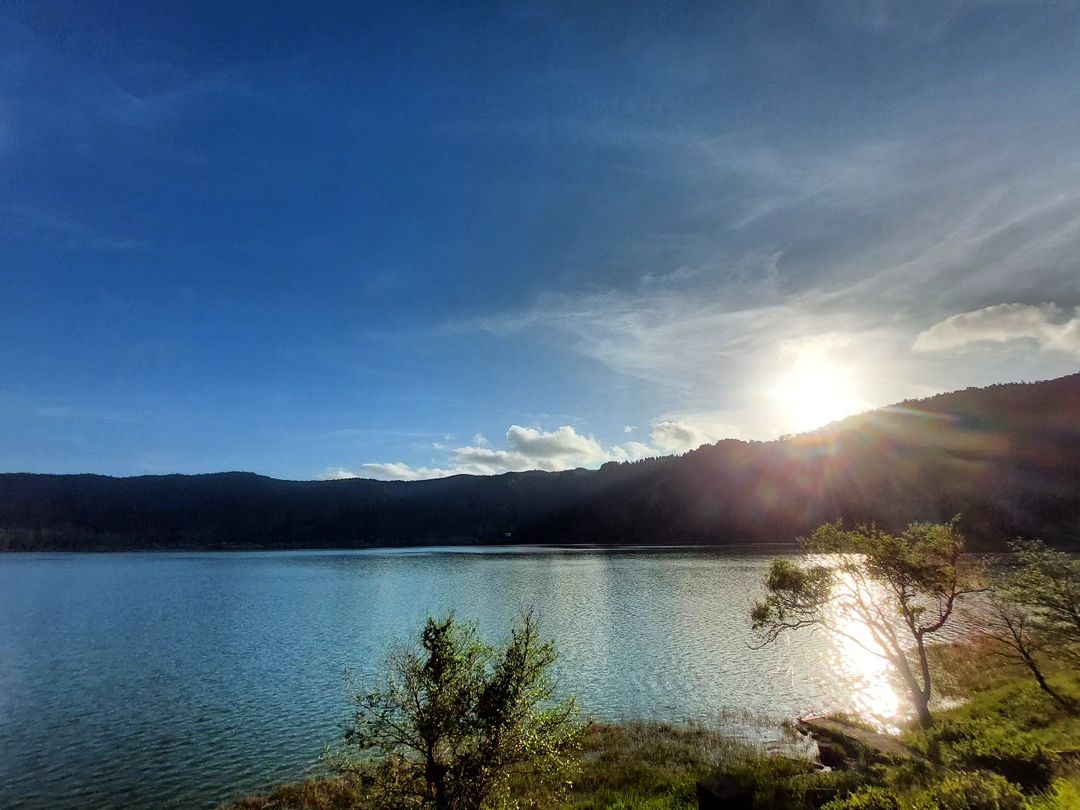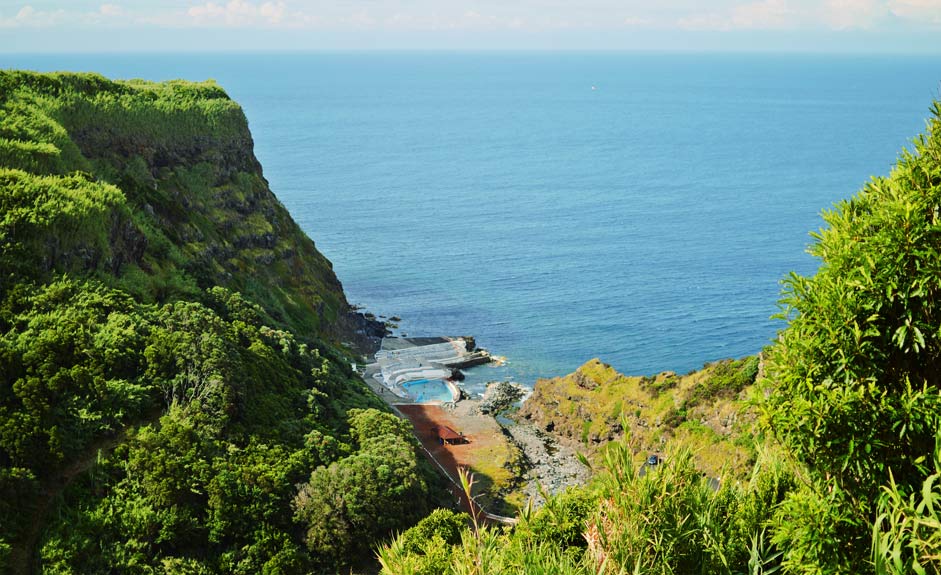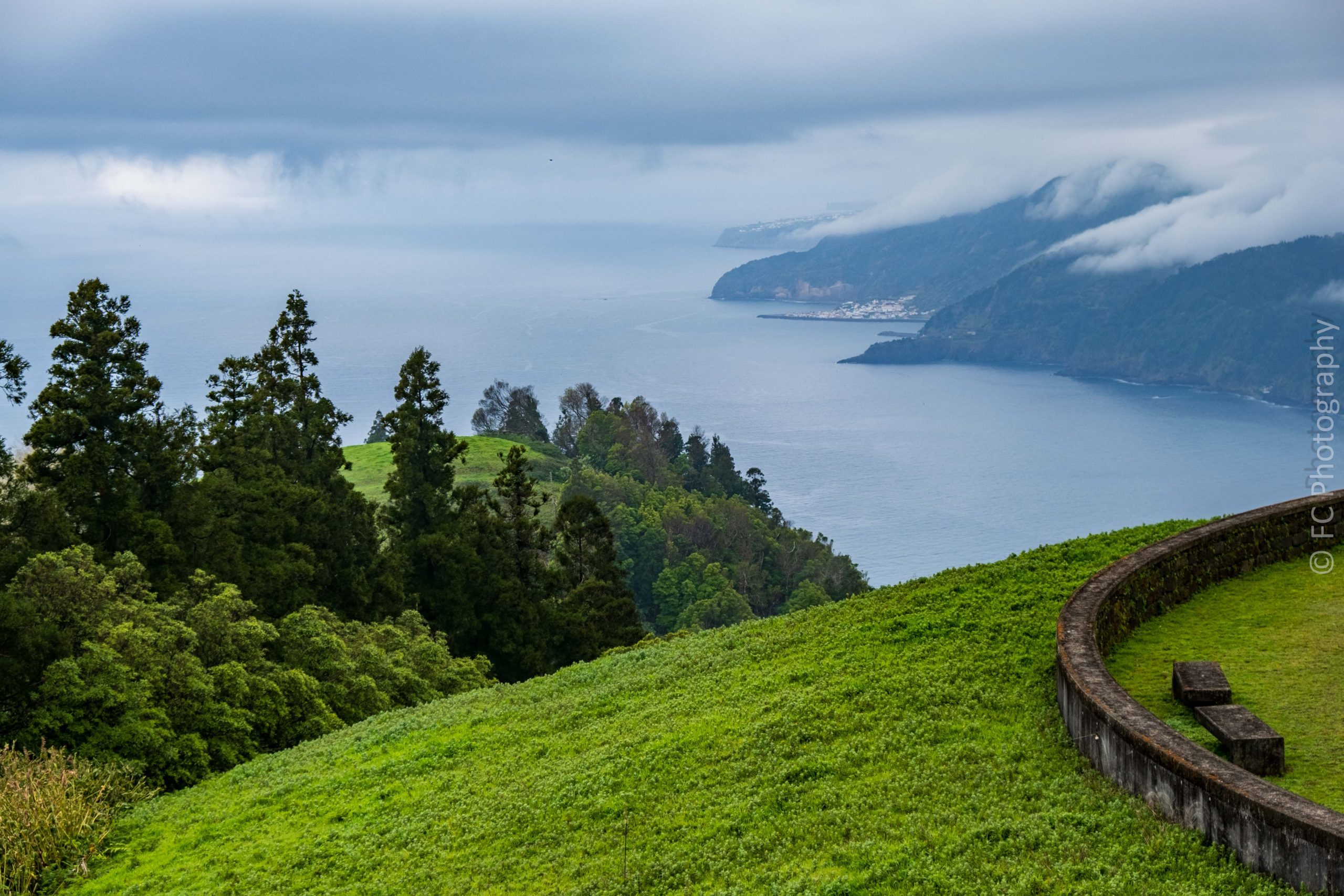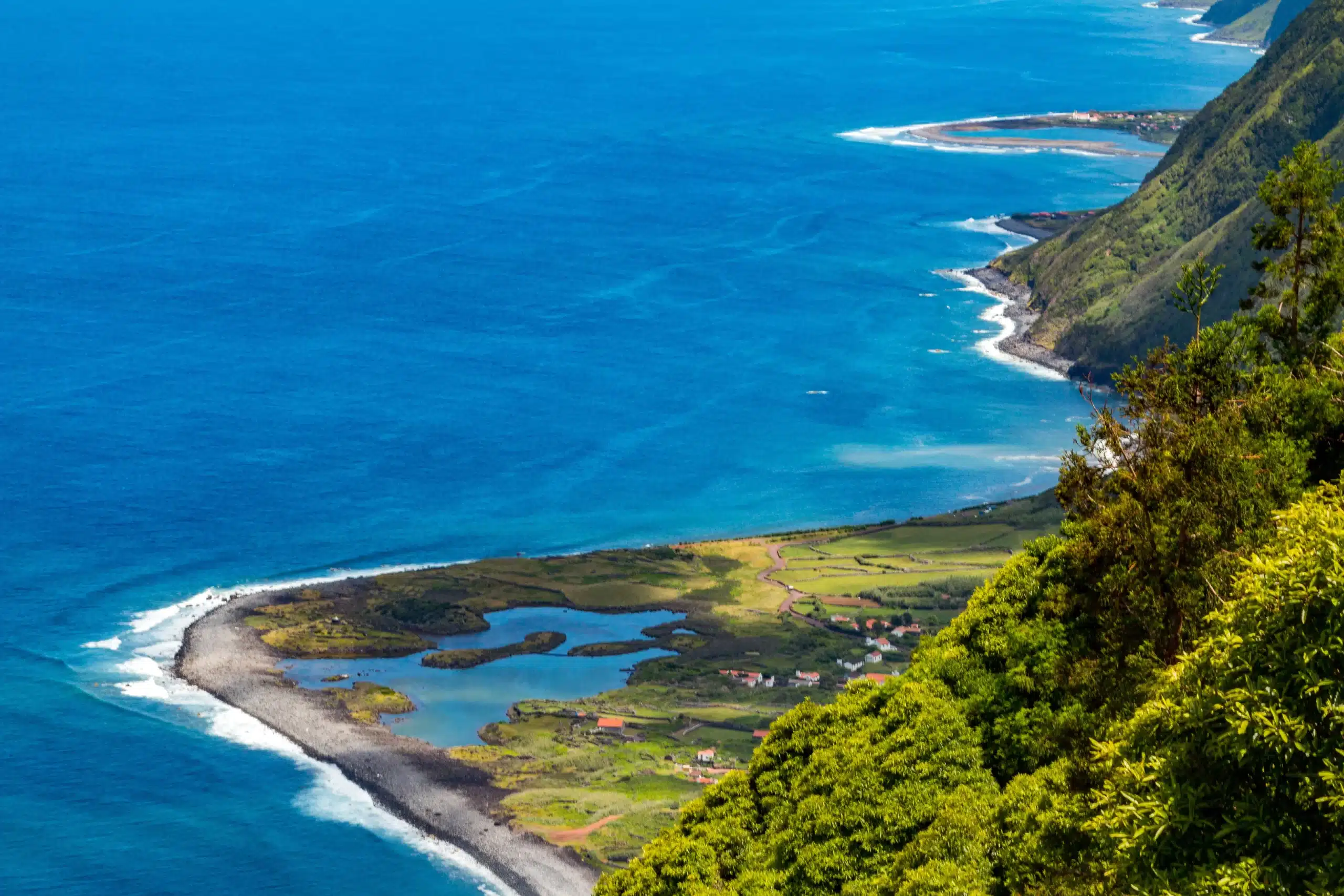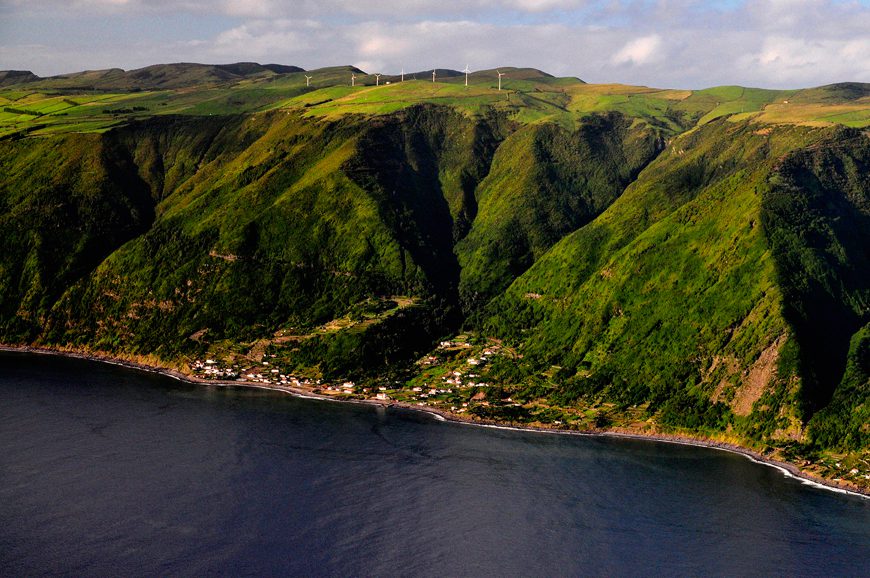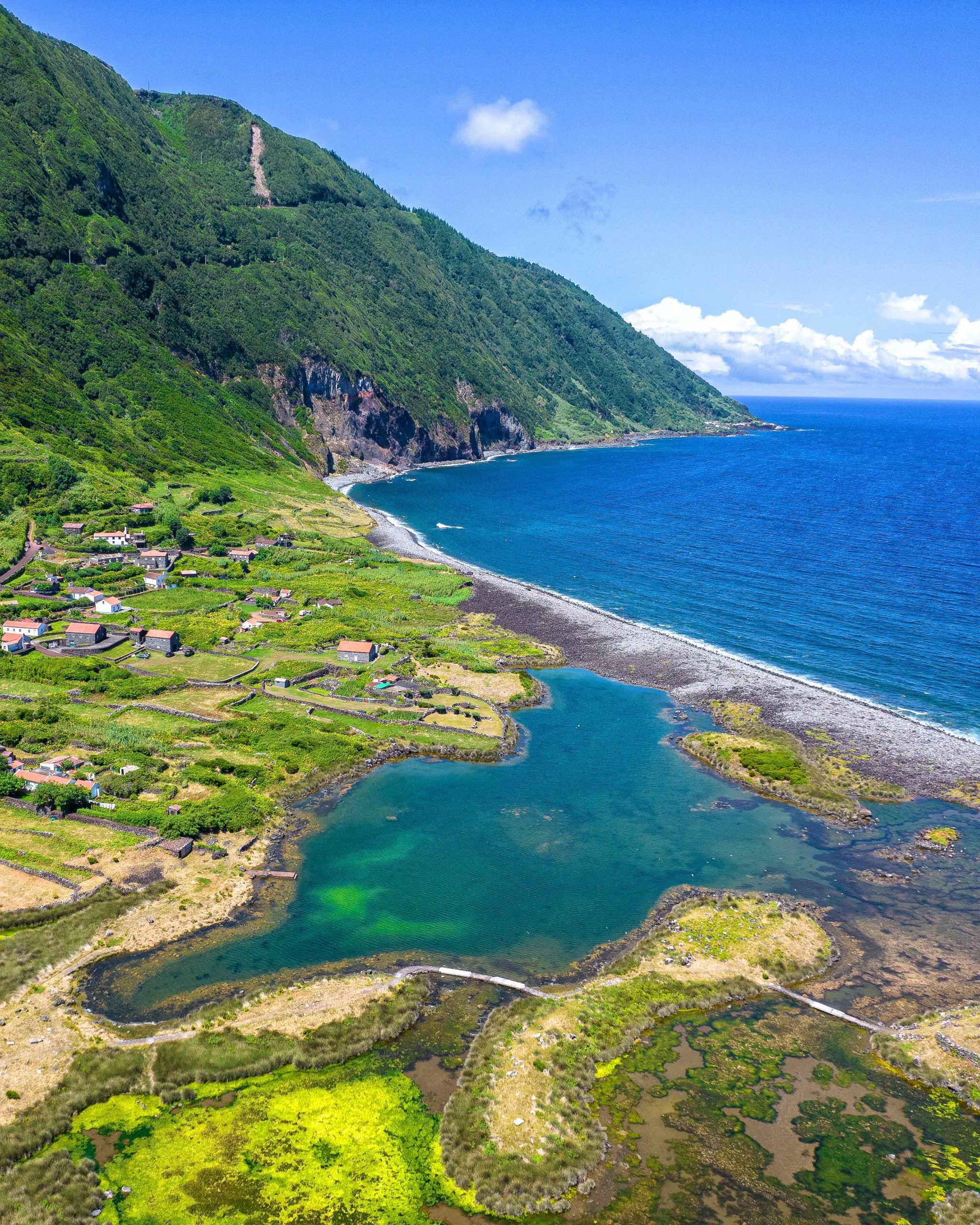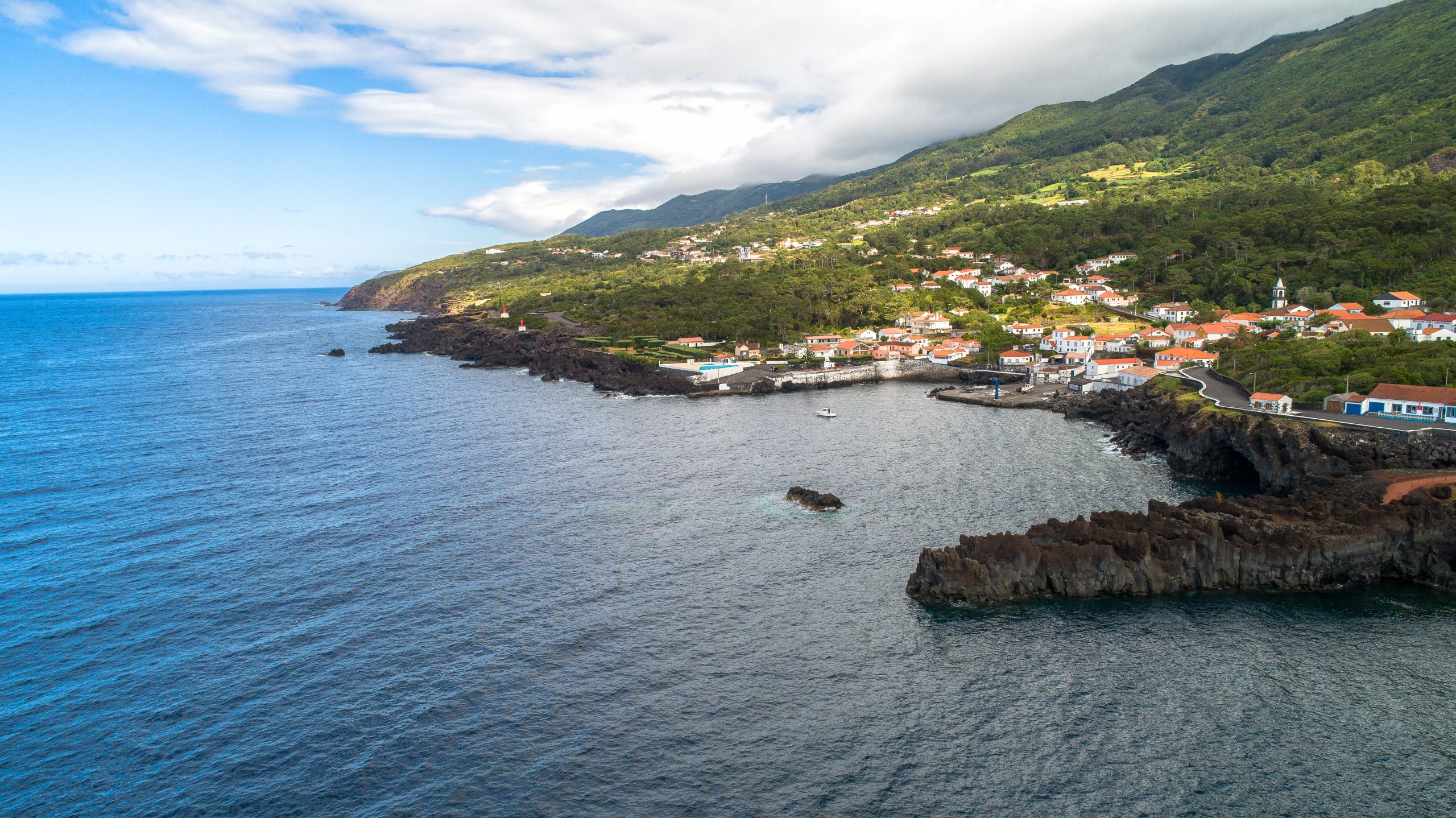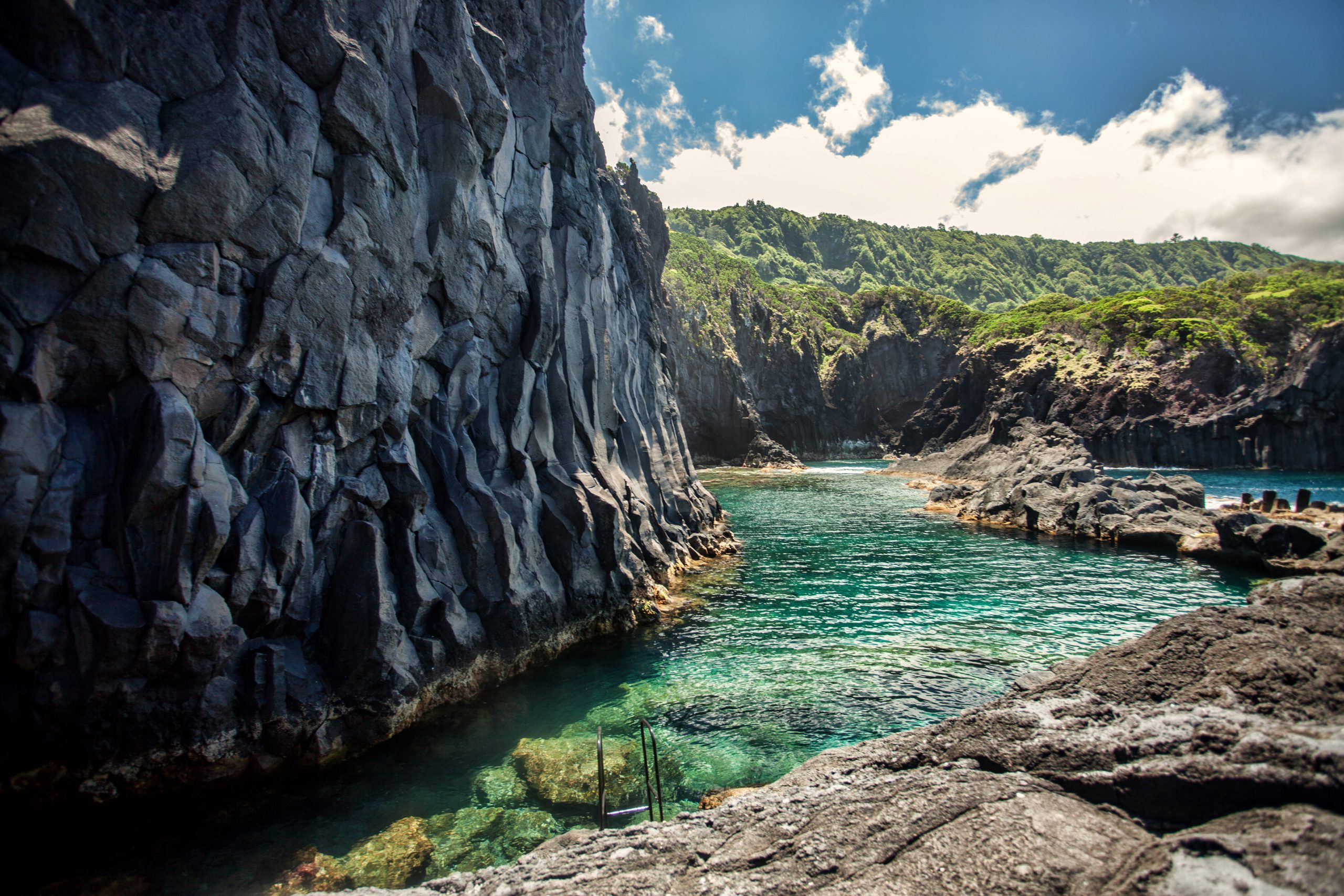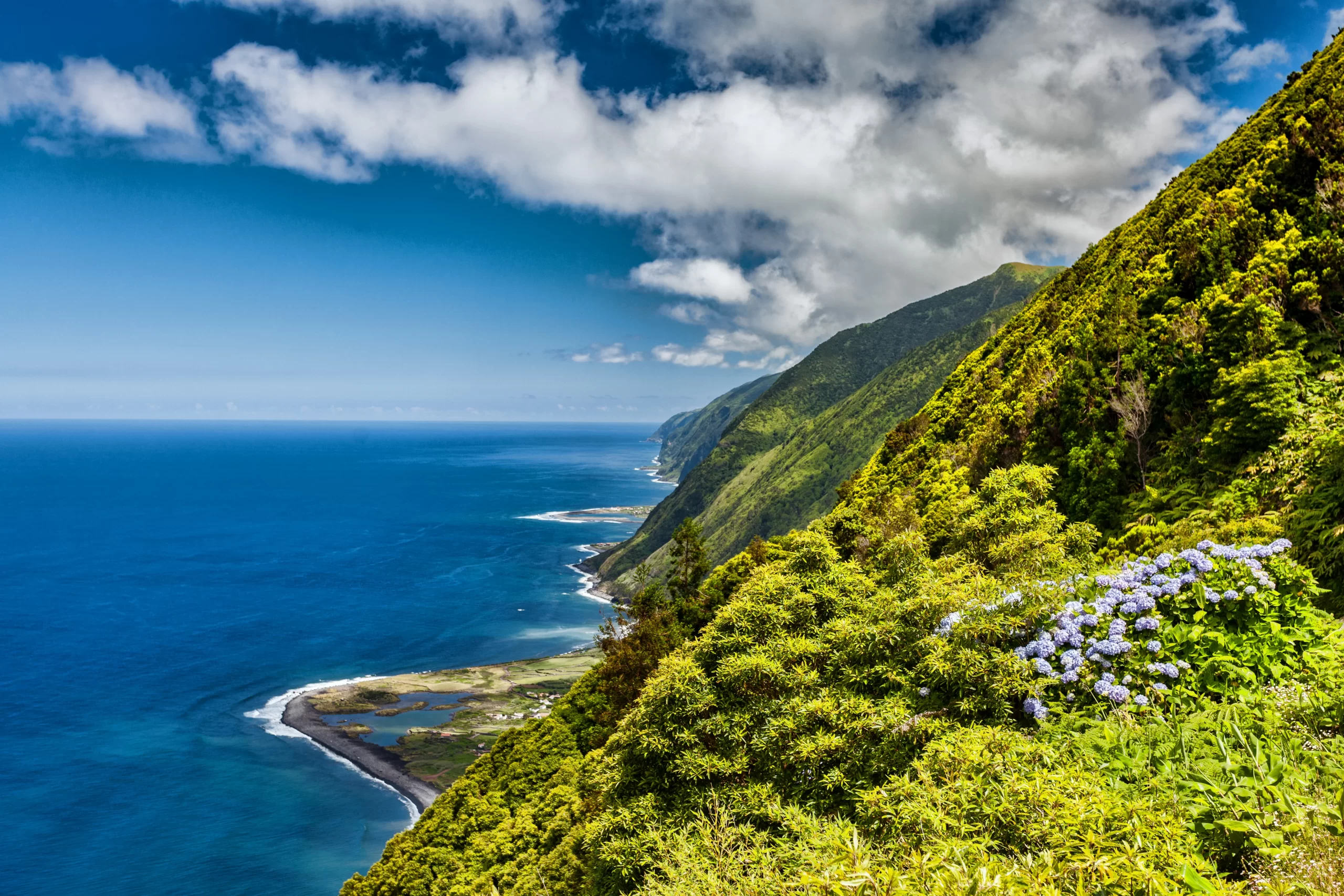Fajã das Almas lies by the sea and boasts an enormous wealth of fauna and flora, making it a rural paradise that has been lost in time. There are currently only around five permanent residents in this Azorean town. Fajã das Almas is located in the parish of Manadas, in the municipality of Velas, on the south coast of the island of São Jorge.
Here, you can enjoy walks along the coast surrounded by breathtaking landscapes. In this article, we’ll talk about this beautiful fajã and point out the places of interest that you can’t miss during your stay on the island.
What is Fajã das Almas

The many fertile cultivated areas and one or two white houses that line this magnificent seaside landscape characterize Fajã das Almas, also known as Fajã do Calhau. In 1891, Fajã do Calhau had a population of 78 inhabitants; however, this number has decreased significantly over time, currently standing at approximately five permanent residents.
However, due to its increased accessibility, there has been a rise in the number of reconstructions, mainly carried out by emigrants. This beautiful Fajã is rich in ancient customs and traditions, one of which is its rich heritage of handicrafts. Here, artisans handcraft wicker baskets, which people mainly used for harvesting and other agricultural work in the past.
In addition to the natural heritage, take the opportunity to discover the various tourist attractions of Fajã das Almas. Here, you can enjoy peaceful moments with your family and friends.
Fauna and Flora
Fajã das Almas lies by the coast and is surrounded by green slopes, making this place uniquely beautiful on the island. The Fajã is currently part of the Fajã das Almas Protected Area for the Management of Habitats or Species.

Did you know
The Fajã das Almas Protected Area for the Management of Habitats or Species covers around 97.1 hectares.
In this protected area, you can find a variety of species in their natural habitats. You will, therefore, be able to observe the fauna here:
- Birds: Roseate Tern and Common Tern; Cory’s Shearwater; Gull; Sparrowhawk; Blackbird; Kite; Mallard; Goose, among others.
- Pisces: Chicharro, Mackerel, Conger, Fork beard, Rockfish, among others.
In terms of flora, you’ll find the following specimens: heather, beech, white wood, Vidalia, and sea fennel, among others. Given its agricultural past, the region commonly features yams, banana trees, coffee, and maize.

What to Do in Fajã das Almas
In this parish, as well as enjoying unique moments, you can take the opportunity to visit and get to know the region’s two monuments:
- Ermida de Santo Cristo: built in 1876. However, in September 1880, the chapel suffered a fire, and its reconstruction was promoted by the Baron of Ribeiro, who blessed it in January 1882.
- Ermida de Nossa Senhora das Almas: Curiously, this Christian temple also suffered a fire, which nearly destroyed it; reconstruction work was necessary.
Don’t forget to visit the natural heritage of Fajã do Calhau:
- Fajã das Almas Viewpoint: with breathtaking views over one of the most beautiful fajãs in São Jorge and the Pico Island;
- Poça da Fajã das Almas: a bathing area with clear water and magnificent views over the island of Pico;
- Fajã das Almas Harbor.
Plan Your Visit to Fajã das Almas
Best Time to Visit
The best time to visit Fajã das Almas, located on São Jorge Island in the Azores, is during the spring months (April to June) and summer months (July to September). During this period, the climate is milder, and the temperatures are more pleasant for exploring the region and enjoying the natural landscapes.
In addition, the flora will be lush, and many outdoor activities, such as hiking, boat trips, and visits to vineyards and orchards, will be possible. The climate in the Azores can be unstable throughout the year, so you should be prepared for weather variations, even during the warmer seasons.
Check all our articles about the weather in the Azores throughout the year 🌤️ ☔️: January | February | March | April | May | June | July | August | September | October | November | December
How to Get to Fajã das Almas
From the town of Velas, in the direction of Fajã das Almas, you have to travel around 16 kilometers via the N1 and EN1 to reach your destination. To travel this route, you have several options at your disposal, so you can choose to drive yourself:
- Car: 20 minutes.
- Public transport: 2 hours and 30 minutes.
- Bicycle: 1 hour and 45 minutes.
However, if you choose to hike, you can do it on foot. It will take approximately 4 hours.
Planning a trip to the Azores? These articles will help you: How to Get to the Azores 🗺️ | Azores airports 🛬 | Flights between islands ✈️ | Ferries between islands ⛴️ | Which island to choose? 🏝️ | What airlines fly to the Azores? 🛩️
Nearby Attractions
Urzelina

Urzelina is a true seaside paradise, located 7.5 kilometers from Fajã das Almas. This pretty village is a parish in the municipality of Velas, on the island of São Jorge. This village is situated by the sea, offering beautiful walks along the coast, surrounded by traditional windmills and breathtaking landscapes.
In this parish, you can enjoy unique moments with your family and friends, and take the opportunity to explore and discover the region’s vast cultural and historical heritage. Here are some suggestions:
- Tower of the Church of Urzelina;
- Church of São Mateus;
- Furna das Pombas (Cave);
- Urzelina Volcano;
- Ponta dos Casteletes Viewpoint;
- Urzelina Natural Pools.
Velas

Velas boasts a rich historical, cultural, and religious heritage, featuring museums, churches, and forts that offer a captivating array of architectural styles. So, if you’re passing through, take the opportunity to stroll through the city’s typical streets and explore its true essence. In addition, this city is the largest on the island and affectionately carries the nickname Cheese Capital of the Azores, offering a wide range of São Jorge cheeses to taste.
Here, you will also find the natural pools of Poça dos Frades and the Preguiça bathing area, which offer a unique diving experience. Volcanic rocks surround the crystal-clear waters, and breathtaking views of the islands of Pico and Faial are also available.
Inland, the Fajãs offer exuberant landscapes:
- Fajã do Ouvidor, with the Poça Simão Dias natural pool;
- Fajã d’Além has its beautiful orchards full of fruit trees.
→ Related Post: Best beaches in the Azores. Read more!
Calheta de São Jorge

Calheta de São Jorge was founded in 1483 and formally declared a town in 1534. It is a peaceful town on the south coast of São Jorge, in the Azores. With around 4,000 inhabitants, it features an iconic 16th-century church that has withstood fires and earthquakes and has been rebuilt three times. From Calheta Harbor, visitors can enjoy exciting activities such as coasteering on the cliffs or canoeing in the middle of the Atlantic Ocean.
Check all our articles about each one of the most relevant points of interest on São Jorge Island: Fajã das Almas | Fajã dos Cubres | Fajã de Santo Cristo | Fajã do Ouvidor | Fajã dos Vimes | Urzelina
Complementary Information
Best Season to Visit the Azores
The Azores Archipelago boasts a unique climate that shapes its lush landscapes, making it a splendid year-round destination. With mild temperatures and minimal fluctuations, each season offers something unique. Spring averages 16 °C, summer reaches 21 °C, autumn cools to 18 °C, and winter remains mild at 14 °C.
→ For a detailed breakdown of the weather by month, check the following links 🌤️☔️: January | February | March | April | May | June | July | August | September | October | November | December
How to Get to the Azores
The Azorean Archipelago is easily accessible through numerous flight routes. Lisbon and Porto are the main entry points to the continent, with direct flights available to São Miguel (PDL), Terceira (TER), Faial (HOR), Pico (PIX), and Santa Maria (SMA). To find the best flight, use search engines like eDreams or Skyscanner. These platforms let you compare prices and schedules from multiple airlines in one convenient location.
For more details on how to get to the Azores, take a look at our complete guide. But what if you want to explore beyond your arrival island? We’ve got you covered!
- Azores airports 🛬
- Flights between islands ✈️
- Ferries between islands ⛴️
- Which island to choose? 🏝️
- What airlines fly to the Azores? 🛩️
→ Once you’ve found the perfect route, book your tickets and get ready to experience one of the world’s most stunning island groups!
Travel Essentials
Essential Information for your Azores trip: Azorean Language & Phrases 🗣️ | Currency & Banks 💵 | Credit Cards & Traveler’s Cheques 🏧 | Driving in the Azores 🚗 | Electricity 🔌 | Experiences & Tours 🗺️ | Health & Safety 🩺 | Internet & Wi-Fi Access 🛜 | Phones & Mobile Service 📞 | Post Offices & Buying Stamps ✉️ | Public Holidays 🏖️ | Shopping 🛒 | Time & Daylight 🕒 | Whale Watching Guide 🐳 | Best Island to Visit 🏞️
Useful Tools & Apps
The weather in the Azores can be variable, so it’s helpful to use some apps before visiting the islands. Spotazores provides live camera feeds from the main tourist attractions, allowing you to check the weather and plan your visit. For accurate weather predictions, use Windy or Windguru — they provide the most reliable predictions.
Video
Conclusion
Fajã das Almas has a unique beauty, the result of the singular landscapes that surround it. This is the ideal place to enjoy walks by the sea with your family and friends, taking advantage of the serenity and tranquility. This is the destination of choice for those seeking a place to rest and relax. Visitors can also visit many natural tourist attractions and historical monuments. What are you waiting for to visit São Jorge Island? Come and discover this rural paradise forgotten in time.
Authors’ Note
I am pleased to inform you that all the recommendations in this article are based on my personal experience and observations. As the author, I have personally visited each attraction mentioned, ensuring that every suggestion is grounded in first-hand knowledge and genuine enthusiasm.
FAQs
Fajã das Almas, also known as Fajã do Calhau, is located on São Jorge Island in the Azores, Portugal, along the island’s rugged coastline.
Fajã das Almas is renowned for its fertile cultivated areas, white houses, and breathtaking seaside landscape, surrounded by lush green slopes. It is a peaceful and remote spot with rich flora and fauna.
Access to Fajã das Almas is quite challenging, as it involves a steep trail, but the journey rewards you with stunning views of the coastline.
Fajã das Almas has a rich agricultural history and is currently part of the Fajã das Almas Protected Area for the Management of Habitats and Species, helping to preserve its unique environment.




